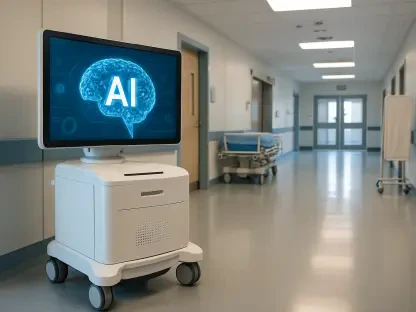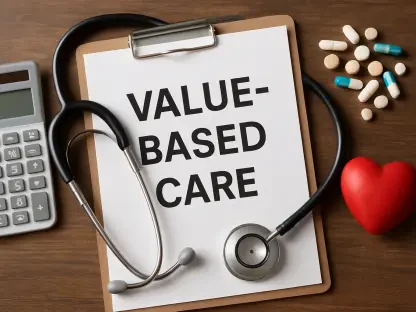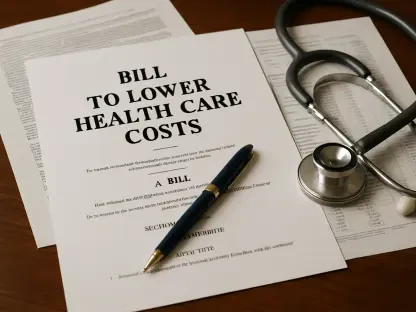In recent years, the healthcare industry has witnessed significant advancements, largely due to the integration of technology into various facets of medical care. One of the most transformative areas has been medication management, which seeks to optimize the prescribing, dispensing, administration, and monitoring of medications to enhance patient safety and therapeutic outcomes. This sector is anticipated to grow at a compound annual growth rate (CAGR) of 8–9% by 2029, driven by technological innovations, regulatory pressures, and evolving healthcare models. These developments underscore the critical role that technology plays in the evolution of medication management, ensuring errors are reduced, patient safety is improved, and healthcare costs are minimized.
Technological Integration in Medication Management
Electronic Health Records and Health Information Technology
Electronic Health Records (EHRs) and Health Information Technology (HIT) systems are at the forefront of revolutionizing medication management by streamlining access to vital patient information. EHRs enhance healthcare providers’ ability to access comprehensive patient data, including medication lists, allergies, and medical histories, thereby facilitating informed prescribing. This integration significantly reduces medication errors, which, if unchecked, could lead to adverse drug events, longer hospital stays, and increased healthcare costs. HIT systems, with their ability to offer real-time decision support, further refine clinical workflows, enabling more accurate and timely medication management decisions, ultimately advancing patient safety standards.
These systems not only optimize administrative tasks but also improve clinical outcomes by promoting coordinated care. By minimizing medication errors and ensuring seamless transitions between care providers, EHRs and HIT tools are pivotal in achieving improved patient adherence and reducing adverse events. Furthermore, HIT enhances communication across multidisciplinary teams, enabling a holistic approach to patient care. The interplay of these technologies signifies a shift towards more efficient and smarter healthcare delivery models, which are essential for responding to the increasing complexities of medication regimens, particularly in chronic disease management.
Computerized Physician Order Entry and E-prescribing Systems
Computerized Physician Order Entry (CPOE) systems and e-prescribing technologies represent indispensable components in the drive to enhance medication accuracy and patient safety. These systems facilitate the electronic entry of medication prescriptions, drastically reducing transcription errors that typically occur with manual handling. The adoption of CPOE systems has proven effective in decreasing medication errors by ensuring prescriptions are legible and by alerting prescribers to potential drug interactions or allergies. This streamlined process not only boosts healthcare efficiency but also fosters patient safety by significantly lowering the incidence of preventable errors.
As healthcare systems continue transitioning towards digital solutions, e-prescribing systems gain prominence, allowing prescriptions to be transmitted electronically from healthcare providers to pharmacies. This process minimizes delays, reduces errors associated with handwritten prescriptions, and enhances the medication adherence rates among patients. E-prescribing also contributes to improved patient management by integrating seamlessly with EHRs, thus permitting healthcare providers to access complete medication histories and make more informed prescribing decisions. The reduced turnaround time and enhanced accuracy fostered by CPOE and e-prescribing systems are indicative of the healthcare industry’s commitment to leveraging technology for improved patient care and cost-effectiveness.
Regulatory Influence and Healthcare Policy Impacts
Regulatory Bodies and Standardization
Regulatory bodies play a crucial role in shaping medication management practices through stringent guidelines and standardization efforts. These entities advocate for the integration of technological solutions aimed at promoting a culture of safety rather than punitive measures. Guidelines set forth by healthcare regulators emphasize error-reporting mechanisms, encouraging healthcare providers to identify and address medication errors without fear of repercussions. This approach fosters an environment where continuous improvement in medication management practices is prioritized, ultimately contributing to safer patient care.
Standardization initiatives, driven by regulatory influence, aim to create a consistent framework for medication management across all healthcare settings. The adoption of standardized protocols facilitates interoperability among various healthcare systems and platforms, ensuring seamless communication and coordination of care. Regulatory bodies emphasize adherence to best practices, encouraging the use of technology to achieve compliance. By mandating these standardization efforts, healthcare systems are directed toward implementing safer prescribing practices, thus reducing the prevalence of adverse drug events and improving overall clinical outcomes.
Guidelines for Safer Medication Practices
The implementation of guidelines that promote safer medication practices serves as a cornerstone in advancing the medication management market. These guidelines advocate for the integration of proactive safety measures, encouraging healthcare providers to adopt technologies such as Clinical Decision Support Systems (CDSS) that offer evidence-based recommendations. CDSS tools guide healthcare professionals by providing alerts and reminders, assisting them in identifying potential errors, drug interactions, and contraindications in real-time. Such systems are instrumental in transforming reactive medication management practices into proactive strategies that prioritize patient safety.
Regulatory guidelines emphasize the importance of comprehensive reporting and surveillance mechanisms to track medication errors and adverse events. These reporting systems provide valuable insights that drive process improvements and policy amendments, ensuring continuous enhancement of medication safety standards. By promoting a collaborative approach among healthcare providers and stakeholders, these guidelines facilitate the development of robust error-prevention strategies. In this way, technology, coupled with regulatory support, emerges as a pivotal element in cultivating an environment where medication management is approached with precision, safety, and efficacy.
Shifts in Healthcare Delivery Models
Transition to Value-Based Care
The transition towards value-based care models is reshaping the landscape of medication management by emphasizing patient outcomes over service volume. In this framework, healthcare providers are incentivized to improve medication adherence, minimize adverse events, and optimize prescribing practices to enhance patient satisfaction and reduce healthcare costs. Value-based care prioritizes patient engagement and education, ensuring patients are well-informed about their medications and empowered to manage their treatment regimens effectively.
The implementation of value-based care models necessitates the integration of sophisticated technologies such as patient portals and mobile health applications. These tools empower patients by providing access to their medication history, enabling them to actively participate in their healthcare decisions. Moreover, these technologies facilitate better communication and coordination between patients and providers, promoting adherence to prescribed therapies. As healthcare systems continue to embrace value-based care, the strategic deployment of technology is critical in advancing the goals of medication management, fostering improved clinical outcomes, and reducing healthcare expenditures.
Enhancing Patient Adherence and Outcomes
Improving patient adherence and outcomes is central to the evolution of medication management systems, particularly in the context of value-based care. Technologies like mobile health apps and telemedicine platforms are transforming patient engagement strategies by providing patients with convenient access to their medication data, reminders, and educational resources. These interventions contribute to a more proactive approach to medication management, where patients are encouraged to adhere to their treatment plans and communicate effectively with their healthcare providers.
Furthermore, advancements in wearable technology and remote monitoring tools offer innovative solutions for tracking patient adherence and real-time health status. These technologies enable healthcare providers to assess medication effectiveness and make timely adjustments to treatment plans, enhancing therapeutic outcomes. The integration of these solutions is crucial in empowering patients to take charge of their health, thereby improving adherence rates and minimizing hospitalization due to preventable complications. By aligning technology with patient-centered care models, healthcare systems can achieve enhanced patient outcomes, crucially supporting the growth trajectory of the medication management market.
Regional Insights and Market Dynamics
Growth in the U.S. and APAC Regions
The United States stands out as a pivotal growth hub for the medication management market, driven by advanced healthcare infrastructure and strong regulatory frameworks. The country’s healthcare system benefits from substantial investments in digital health technologies, enabling the widespread adoption of sophisticated medication management solutions. With initiatives promoting interoperability and data-sharing across healthcare networks, the U.S. market is increasingly aligned with the goals of improved patient safety and medication accuracy, contributing to its robust expansion.
Meanwhile, the Asia-Pacific (APAC) region is experiencing accelerated growth in medication management, primarily fueled by expanding healthcare infrastructure and rising investments in digital health platforms. APAC countries are witnessing a surge in demand for advanced medication management systems as they advance healthcare capabilities to cater to growing populations and chronic disease burdens. Governments in these regions are prioritizing health technology advancements and regulatory policies to support the adoption of medication management solutions, facilitating a conducive environment for market growth. The convergence of technology adoption and regulatory support across these regions underscores the global potential of the medication management market as healthcare systems worldwide endeavor to meet evolving patient needs and improve care delivery models.
Investment in Digital Health Technologies
An increasing investment in digital health technologies is pushing the boundaries of medication management systems worldwide. This trend is evident in the proliferation of innovative tools such as automated dispensing systems and telehealth platforms, which offer enhanced accuracy, efficiency, and patient engagement. These technologies simplify medication management processes, reduce manual errors, and provide healthcare providers with real-time patient data to inform decision-making. With continued technological innovation and investment, medication management systems are poised to advance further, offering new opportunities for improving patient care and healthcare efficacy.
Industry players are allocating substantial resources to research and development initiatives aimed at refining digital health technologies and integrating them into medication management strategies. These investments are vital in achieving breakthroughs in medication safety, adherence, and therapeutic outcomes, ensuring healthcare systems are equipped to manage complex treatment regimens effectively. As digital health innovations propel the medication management market forward, stakeholders from across the sector are poised to benefit from improved clinical efficiencies, reduced costs, and enhanced patient satisfaction. The correlation between technological investments and medication management progress signifies a dynamic and optimistic outlook for the industry’s future.
Competitive Landscape and Strategic Initiatives
Market Players and Growth Strategies
The competitive landscape of the medication management market is characterized by the presence of numerous established players employing strategic initiatives to secure market share and drive growth. Companies are focusing on both organic and inorganic strategies, including partnerships, mergers, and acquisitions, to expand their operations and enhance their technological capabilities. By aligning with other key stakeholders in the healthcare ecosystem, these market players aim to leverage shared expertise and resources to develop innovative medication management solutions that cater to emerging demands.
Product innovation is a cornerstone of market players’ strategies, as they seek to introduce cutting-edge technologies that address the evolving needs of healthcare providers and patients. This approach has led to the development of advanced tools such as predictive analytics, artificial intelligence-based drug management systems, and patient engagement platforms. These innovations underscore the industry’s commitment to delivering superior medication management solutions that optimize care delivery, enhance patient outcomes, and foster growth. As competition intensifies, market players are poised to continue pursuing transformative strategies that align with the shifting dynamics of the healthcare sector.
Collaborative Efforts and Industry Partnerships
Collaborative efforts and partnerships are central to advancing the medication management market, enabling stakeholders to pool resources and expertise for a collective impact on healthcare delivery. Strategic alliances between technology developers, healthcare providers, and regulatory bodies foster a cohesive approach to overcoming medication management challenges and drive industry progress. These partnerships focus on developing interoperable solutions, supporting safe medication practices, and enhancing patient-centered care models, all crucial elements in the market’s evolution.
Industry partnerships also facilitate the exchange of ideas and best practices, promoting the adoption of new technologies across healthcare settings. By engaging in collaborative ventures, stakeholders can harness insights from diverse perspectives, accelerating the development of innovative solutions that address the unique demands of various patient populations. These concerted efforts signify the industry’s determination to leverage technology and collaborative partnerships for comprehensive improvements in medication management, underscoring the potential for continued market growth and transformation. As strategic collaborations gain momentum, the future of medication management is increasingly shaped by shared goals and joint initiatives that prioritize patient safety and healthcare efficacy.
Future Outlook and Emerging Opportunities
Technological Advancements and Market Growth
Technological advancements continue to drive the medication management market, presenting emerging opportunities for growth and innovation. As healthcare systems increasingly adopt digital solutions, technologies such as artificial intelligence, machine learning, and blockchain are poised to play a pivotal role in advancing medication management strategies. These innovations offer enhanced predictive capabilities, security, and efficiency, enabling personalized medication regimens and improved patient care. By leveraging these technologies, healthcare providers can achieve greater accuracy, optimize therapeutic outcomes, and reduce medication costs, essential components in the market’s growth trajectory.
Emerging opportunities in the medication management market are linked to the expansion of pharmacy networks and increased patient engagement strategies. As pharmacies integrate advanced technologies, they can provide comprehensive medication management services, improve patient accessibility, and offer timely interventions. This expansion empowers healthcare providers to deliver holistic care, supporting enhanced medication adherence and patient satisfaction. With continued technological investment and strategic initiatives, the medication management market is set to evolve further, promising new horizons for maximizing healthcare outcomes and fostering sustainable growth across the sector.
R&D Investments and Innovation
Investment in research and development remains a cornerstone of the future outlook for medication management, driving innovation and technological progress. Industry leaders are allocating resources to explore novel solutions that address medication management challenges and enhance healthcare efficacy. R&D initiatives focus on refining existing technologies and introducing disruptive innovations that transcend traditional boundaries, offering unprecedented opportunities to improve patient care, medication adherence, and therapeutic outcomes.
Innovation in the medication management market is increasingly centered on creating personalized and predictive solutions that cater to individual patient needs. By harnessing advanced analytics and data-driven insights, healthcare providers can tailor medication regimens for optimal efficacy and responsiveness. These personalized approaches are essential for achieving improved clinical outcomes, particularly for patients with complex treatment regimens or chronic conditions. As R&D investments continue to fuel innovation, the medication management market stands on the brink of transformative growth, with stakeholders poised to leverage emerging technologies for holistic improvements in healthcare delivery.
Conclusion
In recent years, the healthcare industry has undergone substantial advancements primarily due to the integration of technology across various aspects of medical care. A standout area is medication management, which aims to optimize the entire process of prescribing, dispensing, administering, and monitoring medications. The goal is to improve patient safety and achieve better therapeutic outcomes. This sector is projected to grow at a compound annual growth rate (CAGR) of 8–9% by 2029. This growth is fueled by technological innovations, regulatory demands, and shifts in healthcare models.
These advancements highlight the essential role technology plays in the evolution of medication management. By incorporating cutting-edge solutions, the sector ensures the reduction of errors that can occur during medication processes, enhances patient safety, and aids in minimizing overall healthcare costs. Improved medication management not only reduces risks but also bolsters the efficiency of healthcare delivery, making it a vital component in the modern healthcare landscape. As these technologies continue to develop, there will likely be even more profound impacts on how medications are managed, ultimately leading to enhanced patient care and optimized healthcare systems worldwide.









